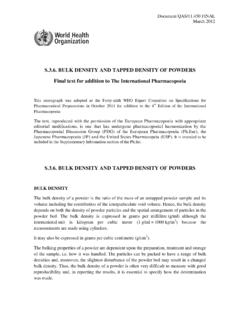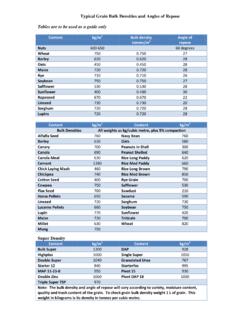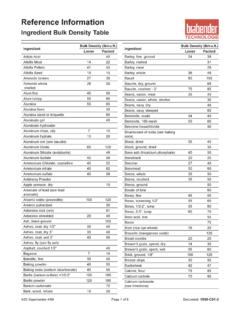Transcription of 37. DRY-BULK DENSITY: ITS USE AND …
1 Taylor, B., Fujioka, K., et al., 1992. Proceedings of the Ocean Drilling Program, Scientific Results, Vol. 126. 1. 37. DRY-BULK density : ITS USE AND DETERMINATION. 2 3 4. Kathleen A. Dadey, Tom Janecek, and Adam Klaus ABSTRACT. Sediment DRY-BULK density values are essential components of mass accumulation rate calculations. This manuscript presents three equations to calculate DRY-BULK density from laboratory measurements of physical properties that have been corrected for the salt content of the pore fluid. In addition, two equations for use with values not corrected for salt content are included. Derivations of the equations from first principles are presented.
2 The second part of the manuscript briefly examines laboratory measurements of the various properties used in the DRY-BULK density equations. A discussion of the problems inherent in the density measurements and recommendations are included. This work represents the first comprehensive compilation of equations of DRY-BULK density and should prove useful to all scientists who investigate accumulation rates. INTRODUCTION Fresh (Distilled Water) Pore Fluid The DRY-BULK density of a sedimentary deposit is a necessary The simplest (and most direct) equation for calculating DRY-BULK component of any accumulation rate calculation ( , mass accumu- density employs the mass and volume measurements in the definition, lation rate = linear sedimentation rate DRY-BULK density ).
3 Mass that is, the mineral mass and the total volume. When the pore fluid accumulation rates incorporate the effects of depositional and post- consists of fresh (distilled) water, the mass of the mineral solids is depositional processes and sediment composition. Gravitational com- equal to the mass of the dry sample. Total volume equals the wet paction is the primary postdepositional process affecting sediment volume. Consequently, the first equation for DRY-BULK density is porosity (and consequently DRY-BULK density ), but other processes such as early diagenetic changes ( , cementation and authigenic = Ms/V, (1). mineral formation) may also result in significant changes in the porosity of the deposit.
4 Consequently, DRY-BULK density values may in which pd = DRY-BULK density , M s = the mass of the dry sample provide additional information and actually prove more useful than (weight of the solid portion of the sample), and V = the total volume sedimentation rates for mass balance calculations. Nevertheless, in (volume of the wet sample). the past, most studies involving accumulation rates used DRY-BULK Mass and volume data are not always available, so we present density data in an inconsistent fashion, generally not explaining its other equations that employ more easily accessible parameters. These origin ( , providing a basic definition), or, in some cases, presenting parameters include porosity ( ), grain density (ps; or grain specific an inaccurate one.)
5 Gravity, which is defined as the ratio of the mass of the mineral grains This note will present six equations used to calculate DRY-BULK density to the mass of an equal volume of fresh water; in the cgs system, it is and will discuss the limitations of each. In addition, we will evaluate the numerically equal to grain density ), water content (we = % dry specific measurements and methods used by the Ocean Drilling Program weight; wc* = % wet weight), wet- bulk density ( Q, and density of (through Leg 126) in the calculation of DRY-BULK density . the pore fluid (pf), a value which can be calculated from the compo- sition of the pore fluid. In all these calculations, we assume that the DRY-BULK density CALCULATIONS sample is saturated; that is the pore spaces are completely filled with fluid.
6 As a consequence, the volume of the pore spaces is equal to that DRY-BULK density is defined as the mass (weight) of the dry solids of the pore fluid. divided by the total volume of the wet sample; that is, DRY-BULK density The equations that result from these parameters are is the ratio of the mass of the mineral grains to the total volume. All index properties are essentially ratios of masses and volumes. Therefore, dry- (l- )ps, (2). bulk density can be calculated directly from mass and volume measure- +wc), and (3). ments, or by relationships with other index properties. We also separate our calculations into two basic types on the basis (4). Pd = Pw ~ (ft ).
7 Of pore fluid composition: (1) those concerned with samples contain- ing pore waters composed of fresh or distilled water, and (2) those To derive Equation 2 from first principles, we define M (total [wet]. containing saline fluids. As calculations involving fresh water are less mass) = M s + Mf, with M s = mass of solid grains and M f = mass of complicated, we begin with these. pore fluid; V = total volume, with Vs = volume of solid grains and Vf = volume of void space ( , the volume of pore fluid); p^, = M/V; . = Vf/V; and ft = Ms/Vs. Therefore, 1. Taylor, B., Fujioka, K., et al., 1992. Proc. ODP, Sci. Results, 126: College Station, (i- ) = (i-vf/v) = (v-vf/v).
8 TX (Ocean Drilling Program). Graduate School of Oceanography, University of Rhode Island, Narragansett, Rl Because V - Vf = Vs, then 02882, 3. Ocean Drilling Program, Texas A&M University, College Station, TX 77845-9547, r s (l - ) = MS/VS(VS/V) = Ms/V = pd. Department of Geology and Geophysics, Uni versaity of Hawaii, 2525 Correa Road, Honolulu, HI 96822, (pesent address: Ocean Research Institute, University of Equations 3 and 4 may be derived in the same manner. Solving for Tokyo, 1-15-1 Minamidai, Nakano, Tokyo 164, Japan). Equation 3 gives the following: 551. K. A. DADEY, T. JANECEK, A. KLAUS. (1 + wc) = 1 + Mf/Ms = (Ms + Mf)/Ms and air. We recommend that samples be weighed stored in a desiccator until the dried samples have cooled to room temperature.
9 (1 + wc) (1/pJ = ([Ms + Mf]/Ms) (V/[MS + Mf]) = V/Ms. The volume measurement is a much less direct technique. On board the JOIDES Resolution, a pycnometer is used routinely to Therefore, determine wet and dry volumes. This method is quick and is specified to a precision of (Quanta-chrome, 1987). The pycnometer relies r w /(l+w c ) = Ms/V = pd. on Archimedes' principle of fluid displacement to determine the sample volume. Helium (He) is used as the displaced fluid, as the Similarly for Equation (4), small gas molecules can penetrate into very small pore spaces. The pycnometer, however, was designed to measure volumes of dry, (ft ) = (Mf/Vf) (Vf/V) = M/V and granular solids, such as powders, not wet sediment samples, and suspicions of inaccurate measurements were expressed as early as Leg rw - (ft ) = ([Ms + Mf]/V) - M/V = (Ms + M f - Mf)/V 110 (Wilkens et al.))
10 , 1990). Inconsistencies in the index property data = MS/V = pd. were noted on Leg 126 as well. As a result, we undertook several experiments to evaluate the source of these anomalous data. Saline Pore Fluid Measurement of solid-metal calibration standards resulted in ac- curacy and precision better than 1 %. It has been suggested (Shipboard The presence of saline pore waters in marine deposits is a poten- Scientific Party, 1988) that inaccuracies observed previously in wet- tially significant complication to DRY-BULK density calculations. Salt sample volumes might result from gas-water interactions. To test this crystals, originally dissolved in the pore fluid, remain as solids after theory, we completed a series of measurements in which known drying, because only fresh water is evaporated.







